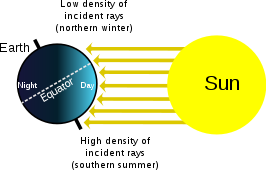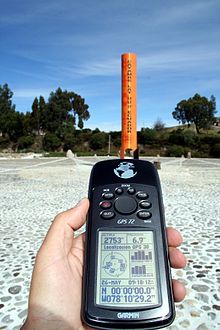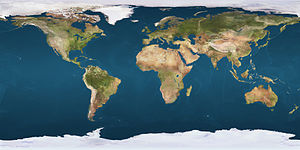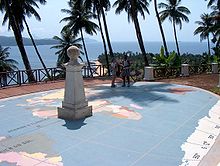
Equator
About this schools Wikipedia selection
This Wikipedia selection is available offline from SOS Children for distribution in the developing world. Sponsoring children helps children in the developing world to learn too.
An equator is the intersection of a sphere's surface with the plane perpendicular to the sphere's axis of rotation and midway between the poles. The Equator usually refers to the Earth's equator: an imaginary line on the Earth's surface equidistant from the North Pole and South Pole, dividing the Earth into the Northern Hemisphere and Southern Hemisphere. Other planets and astronomical bodies have equators similarly defined. The Equator is about 40,075 kilometres (24,901 mi) long; 78.7% is across water and 21.3% is over land.
Geodesy of the Equator
The latitude of the Equator is by definition 0° (zero degrees). The Equator is one of the five notable circles of latitude on Earth, with the others being the two Polar Circles and the two Tropical Circles: the Tropic of Cancer and the Tropic of Capricorn. The Equator is the only line of latitude which is also a great circle. The imaginary circle obtained when the Earth's equator is projected onto the sky is called the celestial equator.
In its seasonal apparent movement across the sky the sun passes over the Equator twice each year, at the March and September equinoxes. At the moment of the equinox, light rays from the centre of the sun are perpendicular to the surface of the earth at the point on the equator experiencing solar noon.
Places on the Equator experience the quickest sunrises and sunsets since the sun rises and sets almost vertically throughout the year. The length of a day (sunrise to sunset) at the Equator is almost constant during the year; each day is about 14 minutes longer than night because of atmospheric refraction and the fact that sunrise/sunset is the moment when the edge of the Sun's disk passes the horizon, rather than its centre.
The Earth bulges slightly at the Equator. Its "average" diameter is 12,750 kilometres (7,922 mi), but at the Equator the diameter is about 43 kilometres (27 mi) greater than at the poles.
Locations near the Equator are good sites for spaceports, such as the Guiana Space Centre in Kourou, French Guiana, as they are moving faster than other latitudes due to the Earth's rotation, and the added velocity reduces the fuel needed to launch spacecraft. Spacecraft must launch to the east, southeast, or northeast to take advantage of this.
Precise location
The Equator, like the Tropics, is not quite fixed. The true equatorial plane is always perpendicular to the Earth's spin axis; this axis is fairly stable but its position drifts about 15 metres (49 ft) during a year and the equator shifts likewise.
Equatorial seasons and climate

Diagram of the seasons, depicting the situation at the December solstice. Regardless of the time of day (i.e. the Earth's rotation on its axis), the North Pole will be dark, and the South Pole will be illuminated; see also arctic winter. In addition to the density of incident light, the dissipation of light in the atmosphere is greater when it falls at a shallow angle.
Seasons result from the yearly revolution of the Earth around the Sun and the tilt of the Earth's axis relative to the plane of revolution. During the year the northern and southern hemispheres are inclined toward or away from the sun according to Earth's position in its orbit. The hemisphere inclined toward the sun receives more sunlight and is in summer, while the other hemisphere receives less sun and is in winter (see solstice). At the equinox the Earth's axis is not tilted toward the sun and the day is about 12 hours long over most of the Earth.
Near the Equator there is little distinction between summer, winter, autumn, or spring. The temperatures are usually high year-round—with the exception of high mountains in South America and in Africa. (See Andes Mountains and Mt. Kilimanjaro.) The temperature at the Equator can plummet during rainstorms. In many tropical regions people identify two seasons: the wet season and the dry season, but many places close to the Equator are on the oceans or rainy throughout the year. The seasons can vary depending on elevation and proximity to an ocean.
The Equator lies mostly on the three largest oceans: the Pacific Ocean, the Atlantic Ocean, and the Indian Ocean. The highest point on the Equator is at the elevation of 4,690 metres (15,387 ft), at 0°0′0″N 77°59′31″W, found on the southern slopes of Volcán Cayambe [summit 5,790 metres (18,996 ft)] in Ecuador. This is slightly above the snow line, and is the only place on the Equator where snow lies on the ground. At the Equator the snow line is around 1,000 metres (3,280 ft) lower than on Mount Everest and as much as 2,000 metres (6,560 ft) lower than the highest snow line in the world near the Tropic of Capricorn on Llullaillaco.
Equatorial countries and territories
The Equator traverses the land and/or territorial waters of 14 countries. Starting at the Prime Meridian and heading eastwards, the Equator passes through:
| Co-ordinates | Country, territory or sea | Notes |
|---|---|---|
| 0°N 0°E | Atlantic Ocean | Gulf of Guinea |
| 0°0′N 6°31′E | Ilhéu das Rolas | |
| 0°0′N 6°31′E | Atlantic Ocean | Gulf of Guinea |
| 0°0′N 9°21′E | ||
| 0°0′N 13°56′E | Passing through the town of Makoua. | |
| 0°0′N 17°46′E | Passing 9 km south of central Butembo | |
| 0°0′N 29°43′E | Passing 32 km south of central Kampala | |
| 0°0′N 32°22′E | Lake Victoria | Passing through some islands of |
| 0°0′N 34°0′E | Passing 6 km north of central Kisumu | |
| 0°0′N 41°0′E | ||
| 0°0′N 42°53′E | Indian Ocean | Passing between Huvadhu Atoll and Fuvahmulah of the |
| 0°0′N 98°12′E | The Batu Islands, Sumatra and the Lingga Islands | |
| 0°0′N 104°34′E | Karimata Strait | |
| 0°0′N 109°9′E | Borneo | |
| 0°0′N 117°30′E | Makassar Strait | |
| 0°0′N 119°40′E | Sulawesi (Celebes) | |
| 0°0′N 120°5′E | Gulf of Tomini | |
| 0°0′N 124°0′E | Molucca Sea | |
| 0°0′N 127°24′E | Kayoa and Halmahera islands | |
| 0°0′N 127°53′E | Halmahera Sea | |
| 0°0′N 129°20′E | Gebe Island | |
| 0°0′N 129°21′E | Pacific Ocean | Passing 570 m north of Waigeo island, Passing 13 km south of Aranuka atoll, Passing 21 km south of Baker Island, |
| 0°0′N 91°35′W | Isabela Island in the Galápagos Islands | |
| 0°0′N 91°13′W | Pacific Ocean | |
| 0°0′N 80°6′W | Passing 24 km north of central Quito, near Mitad del Mundo | |
| 0°0′N 75°32′W | Passing 4.3 km north of the border with Peru | |
| 0°0′N 70°3′W | Amazonas Roraima Amazonas Pará Amapá Pará - islands in the mouth of the Amazon River |
|
| 0°0′N 49°20′W | Atlantic Ocean |
Despite its name, no part of Equatorial Guinea's territory lies on the Equator. However, its island of Annobón is 155 kilometres (100 mi) south of the Equator, and the rest of the country lies to the north.

Crossing the Equator
Certain navies, such as the Royal Navy and the US Navy, have a tradition of holding ceremonies on board ship to mark sailors' first crossing of the Equator. These rites of initiation have in the past been notorious for their brutality. Milder line-crossing ceremonies, typically featuring King Neptune, are also held for passengers' entertainment on some civilian ocean liners and cruise ships.
Exact length of the Equator
In two widely used geodetic standards, the Equator is modeled as a circle whose radius is a whole number of metres. In 1976 the IAU standardized this radius as 6,378.140 kilometres (3,963 mi), subsequently refined by the IUGG to 6,378.137 kilometres (3,963 mi) and adopted in WGS-84, though the yet more recent IAU-2000 has retained the old IAU-1976 value. In either case, the length of the Equator is by definition exactly 2π times the given standard, which to the nearest millimeter is 40,075.016686 kilometres (24,901.460897 mi) in WGS-84 and 40,075.035535 kilometres (24,901.472609 mi) in IAU-1976 and IAU-2000. Although millimeter precision can be important up to the scale of a kilometer, it has negligible physical significance at the scale of a geographic feature such as the Equator.
The geographical mile is defined as one arc minute of the Equator, and therefore has different values depending on which standard Equator is used, namely 1,855.3248 metres (6,087.024 ft) or 1,855.3257 metres (6,087.027 ft) for respectively WGS-84 and IAU-2000, a difference of nearly a millimeter.
The earth is modeled commonly as a sphere flattened 0.336% along its axis. This makes the Equator 0.16% longer than a meridian (as a great circle passing through the two poles). The IUGG standard meridian is, to the nearest millimeter, 40,007.862917 kilometres (24,859.733480 mi), one arc minute of which is 1,852.216 metres (6,076.82 ft), explaining the SI standardization of the nautical mile as 1,852 metres (6,076 ft), more than 3 metres (10 ft) short of the geographical mile.
The sea-level surface of the Earth (the geoid) is irregular, so the actual length of the Equator is not so easy to determine. Aviation Week and Space Technology on 9 October 1961 reported that measurements using the Transit IV-A satellite had shown the equatorial "diameter" from longitude 11 deg West to 169 East to be 1000 feet greater than its "diameter" ninety degrees away.
Climate
Lowlands around the Equator generally have a tropical rainforest climate, also known as an equatorial climate, though cold currents cause some regions to have tropical monsoon climates with a dry season in the middle of the year. Usually, average annual temperature is around 30 °C (86 °F) during the day and 23 °C (73 °F) at night. Rainfall is very high, usually from 2,500 to 3,500 mm per year. Average rainy days are around 200 per year and average annual sunshine hours around 2000.
| Climate data for Macapá, Brazil in South America | |||||||||||||
|---|---|---|---|---|---|---|---|---|---|---|---|---|---|
| Month | Jan | Feb | Mar | Apr | May | Jun | Jul | Aug | Sep | Oct | Nov | Dec | Year |
| Average high °C (°F) | 29.7 (85.5) |
29.2 (84.6) |
29.3 (84.7) |
29.5 (85.1) |
30.0 (86) |
30.3 (86.5) |
30.6 (87.1) |
31.5 (88.7) |
32.1 (89.8) |
32.6 (90.7) |
32.3 (90.1) |
31.4 (88.5) |
30.71 (87.28) |
| Daily mean °C (°F) | 26.4 (79.5) |
26.2 (79.2) |
26.3 (79.3) |
26.5 (79.7) |
26.8 (80.2) |
26.8 (80.2) |
26.8 (80.2) |
27.4 (81.3) |
27.8 (82) |
28.1 (82.6) |
27.9 (82.2) |
27.4 (81.3) |
27.03 (80.65) |
| Average low °C (°F) | 23.0 (73.4) |
23.1 (73.6) |
23.2 (73.8) |
23.5 (74.3) |
23.5 (74.3) |
23.2 (73.8) |
22.9 (73.2) |
23.3 (73.9) |
23.4 (74.1) |
23.5 (74.3) |
23.5 (74.3) |
23.4 (74.1) |
23.29 (73.92) |
| Rainfall mm (inches) | 299.6 (11.795) |
347.0 (13.661) |
407.2 (16.031) |
384.3 (15.13) |
351.5 (13.839) |
220.1 (8.665) |
184.8 (7.276) |
98.00 (3.8583) |
42.60 (1.6772) |
35.50 (1.3976) |
58.40 (2.2992) |
142.5 (5.61) |
2,571.5 (101.2393) |
| Avg. rainy days (≥ 0.1 mm) | 23 | 22 | 24 | 24 | 25 | 22 | 19 | 13 | 6 | 5 | 6 | 14 | 203 |
| Mean monthly sunshine hours | 148.8 | 113.1 | 108.5 | 114.0 | 151.9 | 189.0 | 226.3 | 272.8 | 273.0 | 282.1 | 252.0 | 204.6 | 2,336.1 |
| Source: World Meteorological Organization (UN), Hong Kong Observatory | |||||||||||||
| Climate data for Pontianak, Indonesia in Asia | |||||||||||||
|---|---|---|---|---|---|---|---|---|---|---|---|---|---|
| Month | Jan | Feb | Mar | Apr | May | Jun | Jul | Aug | Sep | Oct | Nov | Dec | Year |
| Average high °C (°F) | 32.4 (90.3) |
32.7 (90.9) |
32.9 (91.2) |
33.2 (91.8) |
33.0 (91.4) |
33.2 (91.8) |
32.9 (91.2) |
33.4 (92.1) |
32.6 (90.7) |
32.6 (90.7) |
32.2 (90) |
32.0 (89.6) |
32.7 (90.9) |
| Daily mean °C (°F) | 27.6 (81.7) |
27.7 (81.9) |
28.0 (82.4) |
28.2 (82.8) |
28.2 (82.8) |
28.2 (82.8) |
27.7 (81.9) |
27.9 (82.2) |
27.6 (81.7) |
27.7 (81.9) |
27.4 (81.3) |
27.2 (81) |
27.7 (81.9) |
| Average low °C (°F) | 22.7 (72.9) |
22.6 (72.7) |
23.0 (73.4) |
23.2 (73.8) |
23.4 (74.1) |
23.1 (73.6) |
22.5 (72.5) |
22.3 (72.1) |
22.6 (72.7) |
22.8 (73) |
22.6 (72.7) |
22.4 (72.3) |
22.7 (72.9) |
| Rainfall mm (inches) | 260 (10.24) |
215 (8.46) |
254 (10) |
292 (11.5) |
256 (10.08) |
212 (8.35) |
201 (7.91) |
180 (7.09) |
295 (11.61) |
329 (12.95) |
400 (15.75) |
302 (11.89) |
3,196 (125.83) |
| Avg. rainy days (≥ 0.1 mm) | 15 | 13 | 21 | 22 | 20 | 18 | 16 | 25 | 14 | 27 | 25 | 22 | 238 |
| Source: World Meteorological Organization (UN) | |||||||||||||
| Climate data for Libreville, Gabon in Africa | |||||||||||||
|---|---|---|---|---|---|---|---|---|---|---|---|---|---|
| Month | Jan | Feb | Mar | Apr | May | Jun | Jul | Aug | Sep | Oct | Nov | Dec | Year |
| Average high °C (°F) | 29.5 (85.1) |
30.0 (86) |
30.2 (86.4) |
30.1 (86.2) |
29.4 (84.9) |
27.6 (81.7) |
26.4 (79.5) |
26.8 (80.2) |
27.5 (81.5) |
28.0 (82.4) |
28.4 (83.1) |
29.0 (84.2) |
28.58 (83.44) |
| Daily mean °C (°F) | 26.8 (80.2) |
27.0 (80.6) |
27.1 (80.8) |
26.6 (79.9) |
26.7 (80.1) |
25.4 (77.7) |
24.3 (75.7) |
24.3 (75.7) |
25.4 (77.7) |
25.7 (78.3) |
25.9 (78.6) |
26.2 (79.2) |
25.95 (78.71) |
| Average low °C (°F) | 24.1 (75.4) |
24.0 (75.2) |
23.9 (75) |
23.1 (73.6) |
24.0 (75.2) |
23.2 (73.8) |
22.1 (71.8) |
21.8 (71.2) |
23.2 (73.8) |
23.4 (74.1) |
23.4 (74.1) |
23.4 (74.1) |
23.30 (73.94) |
| Rainfall mm (inches) | 250.3 (9.854) |
243.1 (9.571) |
363.2 (14.299) |
339.0 (13.346) |
247.3 (9.736) |
54.10 (2.1299) |
6.600 (0.25984) |
13.70 (0.5394) |
104.0 (4.094) |
427.2 (16.819) |
490.0 (19.291) |
303.2 (11.937) |
2,841.7 (111.87614) |
| Avg. rainy days (≥ 0.1 mm) | 17.9 | 14.8 | 19.5 | 19.2 | 16.0 | 3.70 | 1.70 | 4.90 | 14.5 | 25.0 | 22.6 | 17.6 | 177.4 |
| Mean monthly sunshine hours | 176.7 | 182.7 | 176.7 | 177.0 | 158.1 | 132.0 | 117.8 | 89.90 | 96.00 | 111.6 | 135.0 | 167.4 | 1,720.9 |
| Source: World Meteorological Organization (UN), Hong Kong Observatory | |||||||||||||





